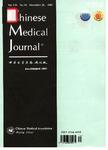Retinal blood flow velocity in patients with active uveitis using the retinal function imager
Retinal blood flow velocity in patients with active uveitis using the retinal function imager作者机构:Beijing Tongren eye Center Beijing Tongren Hospital CapitalMedical University Beijing Ophthalmology and Visual SciencesKey Laboratory Beiiing 100730 China Department of Ophthalmology New York Eye and Ear InfirmaryNew York NY 10003 USA
出 版 物:《Chinese Medical Journal》 (中华医学杂志(英文版))
年 卷 期:2013年第126卷第10期
页 面:1944-1947页
核心收录:
学科分类:1002[医学-临床医学] 100212[医学-眼科学] 10[医学]
主 题:blood supply inflammation edema
摘 要:Background Previous studies suggest a link between macular edema and retinal blood flow velocity (RBFV). The effects of inflammation in the retinal blood vessels are not clearly understood. We want to evaluate the differences in retinal blood flow velocities of patients with active uveitis and healthy controls using the retinal function imager (RFI) and determine the correlation between retinal blood flow velocity and central macular thickness in uveitis patients. Methods Twenty-eight eyes of 24 patients with active anterior uveitis and 51 eyes of 51 normal control subjects were enrolled. Retinal blood flow velocities evaluated by RFI and central macular thickness evaluated by optical coherence tomography (SLO-OCT) were obtained. Differences among the groups were assessed using Stata statistical software. Results Ten eyes had uveitic cystoid macular edema (CME). Median (first quartile, third quartile) venous velocity for uveitic eyes with CME, uveitic eyes without CME, and controls were 2.09 (1.92, 2.44), 2.64 (2.32, 2.86), and 2.82 (2.39, 3.53) mm/s respectively. Median (first and quartile) arterial velocity for uveitic eyes with CME, uveitic eyes without CME, and controls were 3.79 (3.61, 4.09), 3.46 (2.86, 4.12), and 3.93 (3.35, 4.65) mm/s. Uveitic eyes with CME had significantly lower venous velocity than controls (P=0.044). There was a strong linear relationship between venous velocity and central retinal thickness (P=0.007). Conclusions Retinal venous velocities were significantly decreased in eyes with uveitic CME relative to *** venous velocity was correlated with increased central retinal thickness in uveitic eyes.



